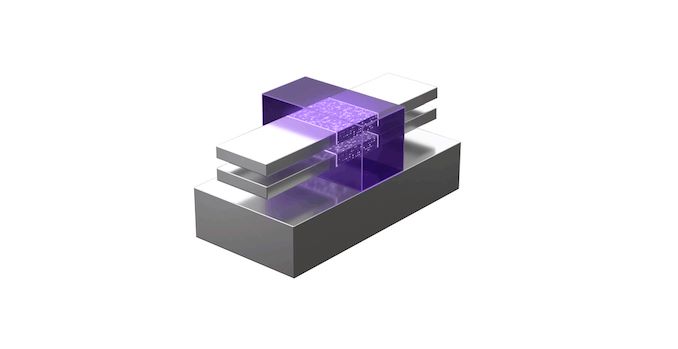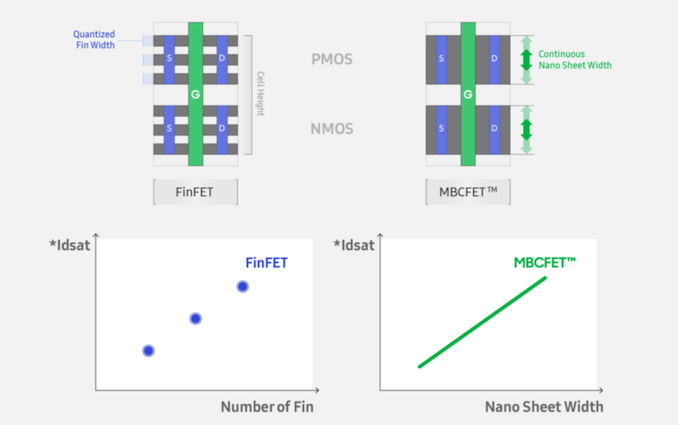Samsung Foundry: 2nm Silicon in 2025
by Dr. Ian Cutress on October 6, 2021 1:02 PM EST
One of the key semiconductor technologies beyond 3D FinFET transistors are Gate-All-Around transistors, which show promise to help extend the ability to drive processors and components to higher performance and lower power. Samsung has always announced that its first generation GAA technology will align with its ‘3nm’ nodes, with its 3GAE and 3GAP processes. As part of the Samsung Foundry Forum today, some more insight was put into the timeline for the rollout, as well as talk of its 2nm process.
It has been widely expected that once the standard FinFET runs out of steam that the semiconductor manufacturing industry will pivot to GAAFET designs. Each of the leading edge vendors call their implementation something different (RibbonFET for Intel, MBCFET for Samsung), but it is all using the same basic principle – a flexible width transistor with a number of layers helping drive transistor current. Where FinFETs relies on multiple quantized fins for source/drain and a cell height of multiple tracks of fins, GAAFETs enable a single fin of variable length, allowing the current for each individual cell device to be optimized in power, performance, or area.
All the big vendors have been discussing GAAFETs in technical semiconductor conferences for a number of years. For example, at the International VLSI conference in June 2020, then Intel CTO Dr. Mike Mayberry showcased a diagram with the enhanced electrostatics of moving to a GAA design. At the time we asked about Intel’s timescale for implementing GAA in volume, and were told to expect them ‘within 5 years’. At present Intel’s RibbonFET is due to come with the 20A process, likely to be productized by the end of 2024. TSMC by contrast is introducing its equivalent technology with its 2nm process nodes, stating that they can extend the life of their FinFET technology for another generation in 3nm. Exact timeline for TSMC's rollout is still quite blurry at this point, as the company expects its N5 and N3 offerings to be extensive long life-time nodes.
Samsung actually surprised us a couple of years back, announcing that it had a version of its GAA technology in prototype in early 2019. The company said that it was shipping its v0.1 development kit to its partners, allowing them to experiment with the early design rules that Samsung required. That has improved over time, and at a presentation a couple of months ago at a China-only conference, the company said that a version of its 3nm GAA technology would be on track for 2022 deployment. Today Samsung is confirming and extending those expectations.
Speaking to Samsung’s MoonSoo Kang, Senior VP of Samsung’s Foundry Market Strategy, he outlined the following timetable for Samsung’s GAA process nodes:
- 3GAE will go into mass production by EoY 2022
- 3GAP will follow in one year for mass production at EoY 2023
- 2GAP will take another couple of years, mass production in 2025
He did add the caveat that these are mass production schedules – product on the shelves will be dependent on customers and their own deployments. From that we usually add one or two quarters (3-6mo) after these times, so 2GAP is realistically a 2026 product for end-users based on these schedules.
This is the first that Samsung is talking about its 2nm process technology, and it comes across as an iterative optimization with what Samsung expects to provide with the 3nm variants. Exact details about performance expectations of these process nodes may be presented later today at the Samsung Foundry Forum 2021 event. Stay tuned for additional coverage.













29 Comments
View All Comments
Oxford Guy - Monday, October 25, 2021 - link
People are constantly told what to do.That's the price to be paid for having governments, which is the price to be paid for having groups of people.
Wereweeb - Friday, October 8, 2021 - link
Sounds like anti-vaxxer talking points but OK, live in your fantasy world where everything must be a conspiracy theory.flyingpants265 - Sunday, October 10, 2021 - link
One of the dumbest comments I've read so far. Congratulations.vortmax2 - Thursday, October 7, 2021 - link
Actually, Covid mutates 4x less often that influenza. This will allow us to squash it sooner than later. The KEY is getting vaccines to large, 3rd world populations to prevent a Delta-variant opportunity pool like what happened in India. We SHOULD be sending every available vaccine to these places and not using resources for boosters yet.Peskarik - Friday, October 8, 2021 - link
Spanish flu happened in time where there was WWI (trench warfare in dirt, excrements, dead bodies etc), malnourishment, no proper medication. Comparing then to now is senseless and misleading. Besides, do you hear anything about cococorona in Africa, Afghanistan etc? It is desease of the rich world, most of the consequences are caused by the "measures" that powerdrunk authorities implement. It is not the "disease" that will be our undoing, it is the authorities and pharma experiments on billions of people.GeoffreyA - Saturday, October 9, 2021 - link
"Besides, do you hear anything about cococorona in Africa"Here in South Africa, we've had more than enough cases. And without any measures, it often would have been worse. (A bit like turning off UAC, antivirus, sandboxing in browsers, etc., etc.)
Peskarik - Friday, October 8, 2021 - link
Read about Marek's desease and about the leaky vaccine that was used to fight it, you will see the future of humanity there.2025 is LOOONG way off, by that time, imho, few will be thinking about 2nm CPUs.
Threska - Wednesday, October 6, 2021 - link
Also is Samsung using ASML machines? That seems to be something that needs to be factored in.ArcadeEngineer - Thursday, October 7, 2021 - link
There is no alternative for ASML machines for anything remotely approaching leading-edge processes.FullmetalTitan - Thursday, October 7, 2021 - link
ASML is the only option for EUV, but Samsung and TSMC split 100% of the first 2 years of production of those scanners, and they are both getting a piece of each year's production since, with Intel picking up a big chunk of 2021/2022 units.